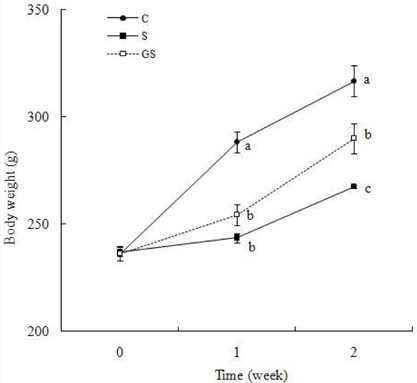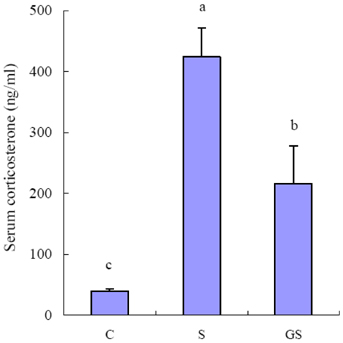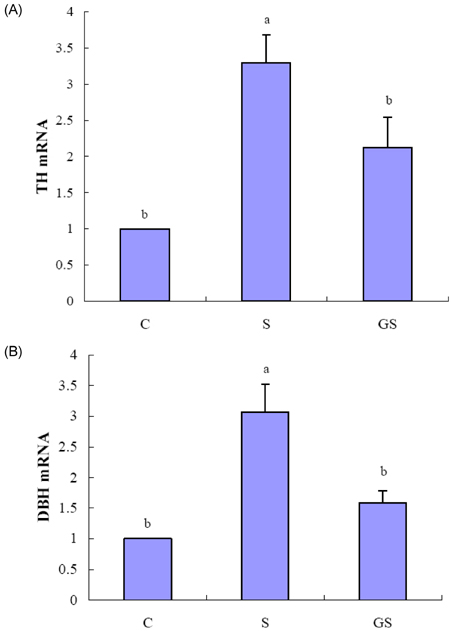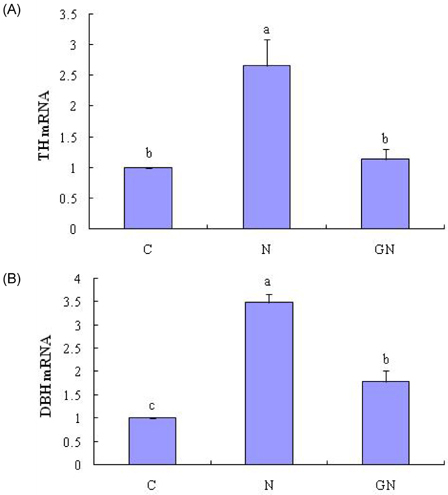Nutr Res Pract.
2010 Aug;4(4):270-275.
Anti-stress effects of ginseng via down-regulation of tyrosine hydroxylase (TH) and dopamine beta-hydroxylase (DBH) gene expression in immobilization-stressed rats and PC12 cells
- Affiliations
-
- 1Department of Nutritional Science and Food Management, Ewha Womans University, 11-1 Daehyun-dong, Seodaemun-gu, Seoul 120-750, Korea. yhmoon@ewha.ac.kr
- 2Food BioNano Research Group, Korea Food Research Institute, Gyeonggi 463-746, Korea.
- 3Department of Food & Nutrition, Korea University, Seoul 136-703, Korea.
Abstract
- Catecholamines are among the first molecules that displayed a kind of response to prolonged or repeated stress. It is well established that long-term stress leads to the induction of catecholamine biosynthetic enzymes such as tyrosine hydroxylase (TH) and dopamine beta-hydroxylase (DBH) in adrenal medulla. The aim of the present study was to evaluate the effects of ginseng on TH and DBH mRNA expression. Repeated (2 h daily, 14 days) immobilization stress resulted in a significant increase of TH and DBH mRNA levels in rat adrenal medulla. However, ginseng treatment reversed the stress-induced increase of TH and DBH mRNA expression in the immobilization-stressed rats. Nicotine as a ligand of the nicotinic acetylcholine receptor (nAChR) in adrenal medulla stimulates catecholamine secretion and activates TH and DBH gene expression. Nicotine treatment increased mRNA levels of TH and DBH by 3.3- and 3.1-fold in PC12 cells. The ginseng total saponin exhibited a significant reversal in the nicotine-induced increase of TH and DBH mRNA expression, decreasing the mRNA levels of TH and DBH by 57.2% and 48.9%, respectively in PC12 cells. In conclusion, immobilization stress induced catecholamine biosynthetic enzymes gene expression, while ginseng appeared to restore homeostasis via suppression of TH and DBH gene expression. In part, the regulatory activity in the TH and DBH gene expression of ginseng may account for the anti-stress action produced by ginseng.
MeSH Terms
-
Adrenal Medulla
Animals
Catecholamines
Dopamine
Dopamine beta-Hydroxylase
Down-Regulation
Gene Expression
Homeostasis
Immobilization
Nicotine
Panax
PC12 Cells
Rats
Receptors, Nicotinic
RNA, Messenger
Saponins
Tyrosine
Tyrosine 3-Monooxygenase
Catecholamines
Dopamine
Dopamine beta-Hydroxylase
Nicotine
RNA, Messenger
Receptors, Nicotinic
Saponins
Tyrosine
Tyrosine 3-Monooxygenase
Figure
Reference
-
1. Chrousos GP. The role of stress and the hypothalamic-pituitary-adrenal axis in the pathogenesis of the metabolic syndrome: neuro-endocrine and target tissue-related causes. Int J Obes Relat Metab Disord. 2000. 24:S50–S55.
Article2. Khansari DN, Murogo AJ, Faith RE. Effects of stress on the immune system. Immunol Today. 1990. 11:170–175.
Article3. Staratakis CA, Chrousos GP. Neuroendocrinology and pathophysiology of the stress system. Ann N Y Acad Sci. 1995. 771:1–18.
Article4. Serova LI, Gueorguiev V, Cheng SY, Sabban EL. Adrenocorticotropic hormone elevates gene expression for catecholamine biosynthesis in rat superior cervical ganglia and locus coeruleus by an adrenal independent mechanism. Neuroscience. 2008. 153:1380–1389.
Article5. Dunn AJ, Kramarcy NR. Iversen LL, Iversen SD, Snyder SH, editors. Neurochemical responses in stress: relationships between the hypothalamo-pituitary-adrenal and catecholamine system. Handbook of psychopharmacology. 1984. vol 18. New York: Plenum Press;455–479.6. Sabban EL, Kvetnanský R. Stress-triggered activation of gene expression in catecholaminergic systems: dynamics of transcriptional events. Trends Neurosci. 2001. 24:91–98.
Article7. Kvetnansky R, Micutkova L, Rychkova N, Kubovcakova L, Mravec B, Filipenko M, Sabban EL, Krizanova O. Quantitative evaluation of catecholamine enzymes gene expression in adrenal medulla and sympathetic Ganglia of stressed rats. Ann N Y Acad Sci. 2004. 1018:356–369.
Article8. Kubovcakova L, Tybitanclova K, Sabban EL, Majzoub J, Zorad S, Vietor I, Wagner EF, Krizanova O, Kvetnansky R. Catecholamine synthesizing enzymes and their modulation by immobilization stress in knockout mice. Ann N Y Acad Sci. 2004. 1018:458–465.
Article9. Sterling CR, Tank WA. Adrenal tyrosine hydroxylase activity and gene expression are increased by intraventricular administration of nicotine. J Pharmacol Exp Ther. 2001. 296:15–21.10. Hiremagalur B, Nankova B, Nitahara J, Zeman R, Sabban EL. Nicotine increases expression of tyrosine hydroxylase gene. J Biol Chem. 1993. 268:23704–23711.11. Choi EH, Lee HJ, Kim CJ, Kim JT, Kwun IS, Kim Y. Anti-stress effects of ginseng in immobilization-stressed rats. Journal of Food Science and Nutrition. 2004. 9:253–258.
Article12. Jeon BH, Kim CS, Kim HS, Park JB, Nam KY, Chang SJ. Effect of Korean red ginseng on blood pressure and nitric oxide production. Acta Pharmacol Sin. 2000. 21:1095–1100.13. Kim DH, Moon YS, Lee TH, Jung JS, Suh HW, Song DK. The inhibitory effect of ginseng saponins on the stress-induced plasma interleukin-6 level in mice. Neurosci Lett. 2003. 353:13–16.
Article14. Dang H, Chen Y, Liu X, Wang Q, Wang L, Jia W, Wang Y. Antidepressant effects of ginseng total saponins in the forced swimming test and chronic mild stress models of depression. Prog Neuropsychopharmacol Biol Psychiatry. 2009. 33:1417–1424.
Article15. Lee SH, Jung BH, Kim SY, Lee EH, Chung BC. The antistress effect of ginseng total saponin and ginsenoside Rg3 and Rb1 evaluated by brain polyamine level under immobilization stress. Pharmacol Res. 2006. 54:46–49.
Article16. Jee HK, Cho YJ, Kim CT, Jang YS, Kim CJ. Increase of solubility of ginseng radix by extrusion cooking. Korean Journal of Food Science and Technology. 2006. 38:361–368.17. National Reseach Council. Guide for the care and use of laboratory animals. 1996. 7th ed. Washington, D.C.: National Academy press;128.18. Rozen S, Skaletsky HJ. Biology KS, Misener S, editors. Primer3 on the WWW for general users and for biologist programmers. Bioinformatics Methods and Protocols: Methods in Molecular. 2000. New Jersey: Humana Press;365–386.
Article19. Weissman C. The metabolic response to stress: an overview and update. Anesthesiology. 1990. 73:308–327.20. Rybkin II, Zhou Y, Volaufova J, Smagin GN, Ryan DH, Harris RB. Effect of restraint stress on food intake and body weight is determined by time of day. Am J Physiol. 1997. 273:R1612–R1622.21. Harris RB, Zhou J, Youngblood BD, Rybkin II, Smagin GN, Ryan DH. Effect of repeated stress on body weight and body composition of rats fed low- and high-fat diets. Am J Physiol. 1998. 275:R1928–R1938.22. Kim CC. Influence of Panax ginseng on the response of stressful stimuli in the experimental animal exposed to various stress. Korean Journal of Ginseng Science. 1979. 3:168–186.23. Hauger RL, Lorang M, Irwin M, Aguilera G. CRF receptor regulation and sensitization of ACTH responses to acute ether stress during chronic intermittent immobilization stress. Brain Res. 1990. 532:34–40.
Article24. Wong DL, Tank AW. Stress-induced catecholaminergic function: transcriptional and post-transcriptional control. Stress. 2007. 10:121–130.
Article25. Tischler AS, Perlman RL, Morse GM, Sheard BE. Glucocorticoids increase catecholamine synthesis and storage in PC 12 pheochromocytoma cell cultures. J Neurochem. 1983. 40:364–370.
Article26. Dhabhar FS, Miller AH, McEwen BS, Spencer RL. Effects of stress on immune cell distribution. Dynamics and hormonal mechanisms. J Immunol. 1995. 154:5511–5527.27. Nonogaki K, Iguchi A. Stress, acute hyperglycemia, and hyperlipidemia: Role of the autonomic nervous system and cytokines. Trends Endocrinol Metabol. 1997. 8:192–197.
- Full Text Links
- Actions
-
Cited
- CITED
-
- Close
- Share
- Similar articles
-
- Effect of immobilization stress on the expression of TH, BDH and CRH gene in rat brain
- Electroacupuncture Analgesia Is Improved by Adenoviral Gene Transfer of Dopamine Beta-hydroxylase into the Hypothalamus of Rats
- Tyrosine Hydroxylase, Dopamine-beta-Hydroxylase and Phenylethanolamine-N-Methyltransferase Immunoreactive Neurons of the Medulla Oblongata in the Apodemus agrarius
- Enhanced tyrosine hydroxylase expression in PC12 cells co-cultured with feline mesenchymal stem cells
- Noradrenergic Changes in an Experimental Model of Parkinsonism Using 6-hydroxydopamine





